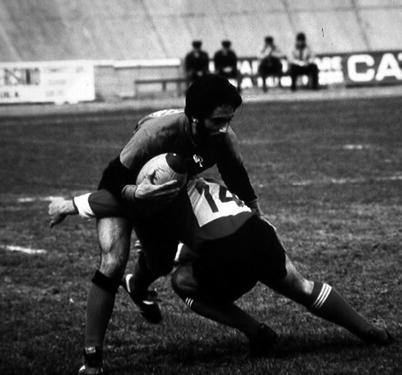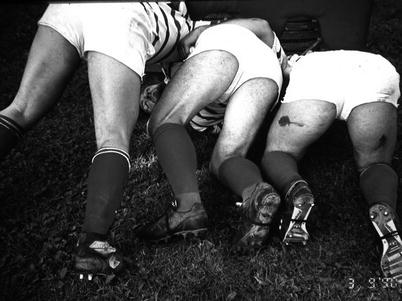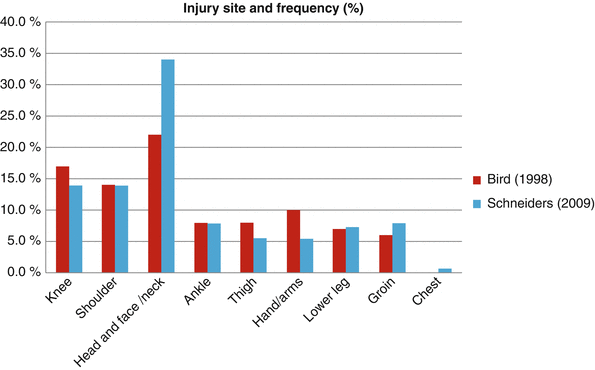Fig. 4.1
Its reported comparison in the incidence of injuries in England regrouped for top 10 injuries site by Brooks (2002/03 and 2003/04 seasons) and Roberts (2009/10, 2010/11 and 2011/12 seasons) studies. Brooks considered only professional players, whilst Roberts three different levels of the game (semiprofessional, amateur and recreational) [6, 14]
Epidemiological studies about rugby injuries include the analysis of incidence and severity of injuries both during the single match and during the season. From the Brooks results, during the match, incidence during the final quarter was higher for players starting a match (114) than for replacement players (87). The higher severity of injuries observed for backs in the third quarter was mainly because 75 % of all ACL injuries sustained by backs (average severity 204 days) occurred during this period; during the season, although there were no significant differences in the monthly incidences of in-season injury, there was a significantly lower incidence of injury during preseason (August) matches compared with the average incidence of injury for in-season matches: it probably reflected the lower competitive nature of the matches (friendlies) played at this time of the season. Also in line with literature, the incidence was higher during the major club competitions than during second team matches. One reason suggested for the higher incidences of injury observed at higher standards of play is the more efficient injury-reporting regimens available at elite clubs because of the superior standard of their medical support [6]. As suggested by Bird and Quarrie studies of 1998 and 2001, respectively, the greater body mass of players at higher playing standards can also contribute to explain these differences. Other factors that may explain the differences include body composition, levels of player fitness and strength, ball in play times and the more competitive nature of matches at higher standards. Bird obtained a detailed analysis: injury events that occurred in club competition games were 87 %, in preseason club games were 8 % and in representative games were 5 % [15, 16] (Fig. 4.2).
4.4 Mechanism of Specific Site Injuries
Many of the lesions of the musculoskeletal system that we find in the game of rugby are absolutely similar to those that we can find in other contact sports, so we wanted to deal with more specificity three skeletal segments that, in our opinion, have a pathophysiology and a peculiar incidence in rugby players: the shoulder, cervical spine and knee.
4.4.1 Shoulder
During a collision sport like rugby, forces applied to the shoulder can either be indirect with the player falling onto his outstretched hand and forearm or directly through a point of impact on the shoulder. Most common shoulder injuries include contusion, acromioclavicular injuries, glenohumeral dislocations, clavicle fractures, rotator cuff tears and muscle sprains, axillary nerve injuries and traumatic myositis ossificans [17].
A number of mechanisms have been identified for injuries to the shoulder and upper extremities. During a rugby match, tackling of an opponent can result in a number of impacts and forces to the shoulder and upper extremities [18] (Fig. 4.3).


Fig. 4.3
During the tackle, a posteriorly directed force can result, in horizontal abduction of the arms and leveraging forces over the glenohumeral joint
McIntosh et al. identified six different tackling methods, all resulting in impact or leveraging forces upon the shoulder [19].
The most common method for tackling is performed from a crouched position with the arms abducted in attempt to reach around the opponent’s trunk. This usually results in an impact directed to the anterior-superior surface of the shoulder and arms. This mechanism can result in a posteriorly directed force resulting in horizontal abduction of the arms and leveraging forces over the glenohumeral joint. Situations where direct impacts and the application of lever forces occur can lead to acromioclavicular joint separations, labral tears, glenohumeral dislocations and clavicle and scapular fractures. The other common tackling method is described as “arm tackling” where the players attempt to tackle the opponent by diving and reaching outwards to grab the ankle for a tripping tackle or grabbing the trunk to slow down or change the direction of the ball carrier [19–21]. Another method of tackling is described as “smothering” where the tackle is attempted from an upright position, wrapping the arms around ball carrier’s trunk and arm to trap the ball so that the ball carrier is unable to pass the ball during the tackling manoeuvre. Additional risk factors can be mentioned for shoulder injury when a tackle occurs, for example, the relative size and speed of the opponent, the direction of movement of the tackler as they approach their opponent and the forces delivered by other team members who are also attempting a tackle. Fuller et al. and King et al. have identified greater risks for injuries when two tacklers are involved and when approaching the ball carrier from the side [22, 23].
4.4.2 Cervical Spine
Cervical spinal injuries have always caused greater interest and concern, and more attention has been directed to the aetiology of these injuries and their preventive measures. Injuries to the cervical column may include musculo-ligamentous strains, cervical vertebral injuries with or without neurological deficit (disc injuries or herniations, cervical fractions, subluxations, dislocations), brachial plexus injuries and central cord damage [17].
Due to the large number of collisions commonly occurring at the scrum, ruck and maul, as well as in tackles [19, 22] and fatiguing nature of the game, cervical spine injuries are common at all levels of the game [24–26]. Cervical spine injuries in the scrum could be due to forces greater than two-thirds of a tonne being spread across the front row [27], and these forces may contribute to the neck being forced into a hyperflexed or hyperextended position [28, 29]. At the ruck and maul, cervical spine injuries may be caused by the neck being forcefully positioned into flexion whilst the player is in a vulnerable position such as being on the ground [28]. Finally, with reference to tackling, both the ball carrier and tackler are at risk of cervical spine injury. Under normal circumstances, the forces transmitted to the cervical spine are dissipated by energy capabilities of muscles, discs and, to a lesser extent, ligaments. When a force applied to the cervical spine exceeds the elastic capabilities of involved structures, injuries occur. Mechanical input to the head and neck can either be slow (static loading) occurring gradually or, more commonly, rapidly (dynamic loading) during impact on the head. With neck flexion the normal lordosis is obliterated. As the spine becomes a straight column, forces are transmitted directly to the vertical discs and ligaments rather than to the muscles. When maximum vertebrae compression deformation is reached, the structure becomes unstable and buckles. Compressive fractures develop and discs and ligaments fail subsequently. Hyperflexion, developing in rugby-playing facets like the scrum must still be regarded as an important mechanism of injury. Hyperflexion precedes cervical subluxation and facet dislocation [17] (Fig. 4.4).


Fig. 4.4
In rugby scrum, the cervical spine hyperflexion must still be regarded as an important mechanism of injury with subsequent facet subluxation and/or dislocation
Shelly et al. in their study about spinal injuries in rugby reported that “Interestingly, there are national differences in the proportion of injuries occurring in the different phases of play. In South Africa and Ireland there are fewer injuries in the scrum and more in the tackle, whereas in Argentina and Australia, scrums account for the majority of injuries. The explanations for these geographical differences are not clear, but this discrepancy does indicate that different preventive measures need to be emphasised in different countries” [29].
Different approaches may be considered to reduce the incidence of cervical spine injuries in rugby union: rule changes [25, 30] and correct tackling technique [19, 31] have been suggested to reduce the risk of cervical spine injury [32].
Since the modification of these rules, there has not been a serious scrum-related cervical spine injury in Australian rugby. In a New Zealand study, Burry and Gowland [33] also showed a threefold decrease in the incidence of cervical spine injuries when similar rules were adopted to slow the pace of scrum engagement [34].
4.4.3 Knee
As reported by Dallalana et al. in their study published in 2007, “the knee was not the most common injury location… but it caused the largest proportion of total days absent (21 %) from playing and training compared with injuries sustained to other body parts”. The incidence of knee injuries sustained during match play (11.0 injuries per 1,000 player-hours) was significantly higher than the incidence during training (0.16 injuries per 1,000 player-hours). The most common knee injuries were MCL injuries and minor injuries, predominately soft tissue hematomas or a loosely defined “sprain or jar” of the knee.
The incidence of ACL injuries in matches and training was lower than all other knee injury categories; however they had the greatest average severity and consequently caused the highest proportion of days absent from playing and training due to knee injuries. MCL injuries and chondral/meniscal injuries also caused a high proportion of the days of absence due to knee injuries. A higher proportion of match knee injuries were sustained in contact (72 %) than in training (48 %); ACL, MCL and other minor injuries occurred more often in contact than the other injury categories for both match play and training. The most common match injury mechanism was being tackled, for all injury categories except patellofemoral/extensor mechanism injuries. Angular forces across the knee incurred during a tackle or collapsed maul are high and sufficient to cause significant collateral ligament injury, although none of the injuries required surgical repair or reconstruction of the MCL. A greater proportion of the ACL injuries to professional rugby union players in the mentioned study (86 %) were sustained during contact with other players. This disparity may result from the fact that a larger proportion of actual playing time is spent in some form of contact or in collision with other players than in other “non-contact” sports such as soccer and handball; it therefore follows that more injuries of all types, including ACL injury, will occur during contact. Furthermore, they can involve acts of cutting or pivoting at speed, often whilst being thrown off balance. However, the exact mechanisms of these high-risk injuries need to be examined in greater detail using video analysis and three-dimensional modelling. ACL injuries (89 %; one partial tear was not reconstructed) and chondral/meniscal injuries (49 %) required operation most frequently, resulting in a significantly greater absence from playing and training compared with injuries that were not operated on.
Stay updated, free articles. Join our Telegram channel

Full access? Get Clinical Tree







